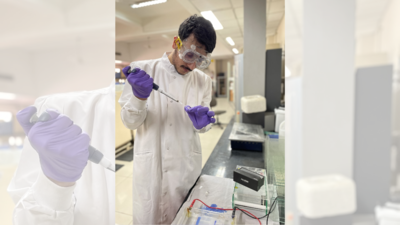-
LONDON: Run For Modi” Event In London To Drum Up Support For PM Modi - 13 hours ago
-
LONDON: Indian-Origin Candidate On How He Plans To Win London Mayoral Polls - 2 days ago
-
HARVARD: No Country Is Perfect”: Physics Wallah Urges Indian Students At Harvard, Stanford To Return - April 27, 2024
-
CALIFORNIA: PM Modi Put India On World Map As Credible Innovator- IT Industry Leaders - April 26, 2024
-
WASHINGTON: Indian Students Bag NASA Awards For Human Exploration Rover Challenge - April 25, 2024
-
LONDON: Indian-Origin Teen In UK Gets “Life-Changing” Cancer Treatment - April 25, 2024
-
SILICON VALLEY: All About Pavan Davuluri, New Head Of Microsoft Windows - April 25, 2024
-
LONDON: UK’s India Gate To Commemorate Role Of Indian Soldiers From World Wars - April 24, 2024
-
HARARE: Shri Bramha Kumar appointed as the next Ambassador of India to the Republic of Zimbabwe - April 23, 2024
-
LONDON: Indian-Origin Principal Wins UK Legal Challenge Over School Prayer Ban - April 23, 2024
BENGALURU: Indian scientists unravel genetic secrets behind lumpy skin disease outbreak
BENGALURU: In a breakthrough, a multi-institutional team of Indian scientists has unveiled critical insights into the evolution and origins of the Lumpy Skin Disease Virus (LSDV) strains fueling the outbreak.
“In May 2022, cattle across India began dying of a mysterious illness. Since then, about 1 lakh cattle heads have been lost to a devastating outbreak of what scientists have identified as LSDV. The outbreak has severely affected India’s agricultural sector, leading to staggering economic losses,” IISc said Tuesday.
IISc’s Prof Utpal Tatu, who is part of the multi-institutional team that probed the cause of the outbreak termed it a “calamity” in some ways, “a national emergency”.
The team’s study, published in the journal BMC Genomics, provides a comprehensive genomic analysis of the LSDV variants circulating in India, shedding light on the virus’s enhanced virulence and the severity of the disease.
“The biggest challenge was the lack of an established LSDV genome sequencing and analysis pipeline. We had to adapt techniques from Covid-19 research,” said Ankeet Kumar, a PhD student at IISc and co-lead author of the study.
Researchers conducted advanced whole-genome sequencing of 22 samples collected from infected cattle in various states, including Karnataka, Gujarat, Maharashtra and Rajasthan. Their analysis revealed two distinct LSDV variants — one with a low number of genetic variations and another with a high number of variations.
Alarmingly, the highly varied strain was found to be similar to LSDV strains from an outbreak in Russia in 2015, suggesting a possible introduction of a foreign strain into India. Moreover, the team identified over 1,800 genetic variations, including deletions, insertions, and single-letter changes in DNA, many of which were found in viral genes critical for host cell binding, immune evasion, and efficient replication.
“Cattle developed more severe symptoms in areas where we found highly diverse strains. This suggests that the genetic variations could elevate virulence,” Kumar said, while Tatu said the genomic data will prove invaluable for vaccine development by revealing molecular hotspots and genetic variations to target.
IISc said that the study represents an example of the One Health approach in which multidisciplinary teams, including molecular biologists, computational experts and veterinary doctors come together to address issues of national relevance.
Tatu emphasised how collaboration between veterinary experts and multiple scientific institutions was critical to tracing the variants across the country. “We learned a lot from the veterinary doctors. They understand the field knowledge, and their perception about the disease was very important,” Tatu said.
























